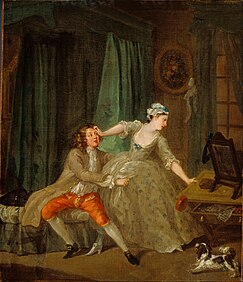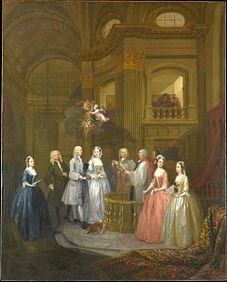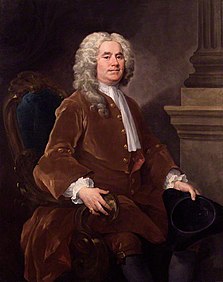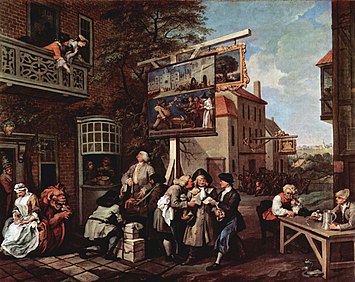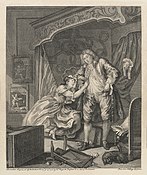William Hogarth
William Hogarth engraver, satirist | |
|---|---|
| Spouse | Jane Thornhill |
| Patron(s) | Mary Edwards (1705–1743)[1] |
| Signature | |
 | |
William Hogarth
Hogarth was born in
Influenced by French and Italian painting and engraving,[5] Hogarth's works are mostly satirical caricatures, sometimes bawdily sexual,[6] mostly of the first rank of realistic portraiture. They became widely popular and mass-produced via prints in his lifetime, and he was by far the most significant English artist of his generation. Charles Lamb deemed Hogarth's images to be books, filled with "the teeming, fruitful, suggestive meaning of words. Other pictures we look at; his pictures we read."[7][8]
Early life
William Hogarth was born at Bartholomew Close in London to Richard Hogarth, a poor
Young Hogarth also took a lively interest in the street life of the metropolis and the London fairs, and amused himself by sketching the characters he saw. Around the same time, his father, who had opened an unsuccessful Latin-speaking
In 1720, Hogarth enrolled at the original
Hogarth became a member of the Rose and Crown Club, with Peter Tillemans, George Vertue, Michael Dahl, and other artists and connoisseurs.[14]
Career
By April 1720, Hogarth was an
In 1727, he was hired by Joshua Morris, a tapestry worker, to prepare a design for the Element of Earth. Morris heard that he was "an engraver, and no painter", and consequently declined the work when completed. Hogarth accordingly sued him for the money in the Westminster Court, where the case was decided in his favour on 28 May 1728.[15]
Early works

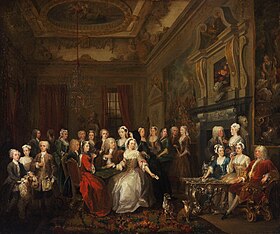
Early satirical works included an
Other early works include

In 1726, Hogarth prepared twelve large engravings illustrating
In the following years, he turned his attention to the production of small "
One of Hogarth's masterpieces of this period is the depiction of an amateur performance by children of John Dryden's The Indian Emperour, or The Conquest of Mexico by Spaniards, being the Sequel of The Indian Queen (1732–1735) at the home of John Conduitt, master of the mint, in St George's Street, Hanover Square.[21][22]
Hogarth's other works in the 1730s include
Moralizing art
Harlot's Progress and Rake's Progress
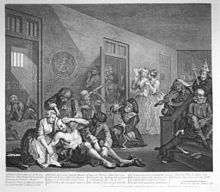
In 1731, Hogarth completed the earliest of his series of moral works, a body of work that led to wide recognition. The collection of six scenes was entitled
The inaugural series was an immediate success and was followed in 1733–1735 by the sequel A Rake's Progress.[34][35] The second instalment consisted of eight pictures that depicted the reckless life of Tom Rakewell, the son of a rich merchant, who spends all of his money on luxurious living, services from prostitutes, and gambling – the character's life ultimately ends in Bethlem Royal Hospital. The original paintings of A Harlot's Progress were destroyed in the fire at Fonthill House in 1755; the oil paintings of A Rake's Progress (1733–34) are displayed in the gallery room at Sir John Soane's Museum, London, UK.[36]
When the success of A Harlot's Progress and A Rake's Progress resulted in numerous pirated reproductions by unscrupulous printsellers, Hogarth lobbied in parliament for greater legal control over the reproduction of his and other artists' work. The result was the Engravers' Copyright Act (known as 'Hogarth's Act'), which became law on 25 June 1735 and was the first copyright law to deal with visual works as well as the first to recognise the authorial rights of an individual artist.[37]
Marriage A-la-Mode
In 1743–1745, Hogarth painted the six pictures of This moralistic warning shows the miserable tragedy of an ill-considered marriage for money. This is regarded by many as his finest project and may be among his best-planned story serials.
Marital ethics were the topic of much debate in 18th-century Britain. The many marriages of convenience and their attendant unhappiness came in for particular criticism, with a variety of authors taking the view that love was a much sounder basis for marriage. Hogarth here painted a satire – a genre that by definition has a moral point to convey – of a conventional marriage within the English upper class. All the paintings were engraved and the series achieved wide circulation in print form. The series, which is set in a Classical interior, shows the story of the fashionable marriage of Viscount Squanderfield, the son of bankrupt Earl Squander, to the daughter of a wealthy but miserly city merchant, starting with the signing of a marriage contract at the Earl's grand house and ending with the murder of the son by his wife's lover and the suicide of the daughter after her lover is hanged at
William Makepeace Thackeray wrote:
This famous set of pictures contains the most important and highly wrought of the Hogarth comedies. The care and method with which the moral grounds of these pictures are laid is as remarkable as the wit and skill of the observing and dexterous artist. He has to describe the negotiations for a marriage pending between the daughter of a rich citizen Alderman and young Lord Viscount Squanderfield, the dissipated son of a gouty old Earl ... The dismal end is known. My lord draws upon the counsellor, who kills him, and is apprehended while endeavouring to escape. My lady goes back perforce to the Alderman of the City, and faints upon reading Counsellor Silvertongue's dying speech at Tyburn (place of execution in old London), where the counsellor has been 'executed for sending his lordship out of the world. Moral: don't listen to evil silver-tongued counsellors; don't marry a man for his rank, or a woman for her money; don't frequent foolish auctions and masquerade balls unknown to your husband; don't have wicked companions abroad and neglect your wife, otherwise you will be run through the body, and ruin will ensue, and disgrace, and Tyburn.[41]
Industry and Idleness

In the twelve prints of
- "Industry and Idleness, shown here, 'Proverbs Ch:10 Ver:4 The hand of the diligent maketh rich.'"
Beer Street and Gin Lane

Later prints of significance include his pictorial warning of the consequences of alcoholism in
In Beer Street, people are shown as healthy, happy and prosperous, while in Gin Lane, they are scrawny, lazy and careless. The woman at the front of Gin Lane, who lets her baby fall to its death, echoes the tale of Judith Dufour, who strangled her baby so she could sell its clothes for gin money.[47] The prints were published in support of the Gin Act 1751.
Hogarth's friend, the magistrate Henry Fielding, may have enlisted Hogarth to help with propaganda for the Gin Act; Beer Street and Gin Lane were issued shortly after his work An Enquiry into the Causes of the Late Increase of Robbers, and Related Writings, and addressed the same issues.[48]
The Four Stages of Cruelty

Other prints were his outcry against inhumanity in
The second shows Tom Nero has grown up to become a
In the third print, Tom is shown to be a murderer, surrounded by a mob of accusers. The woman he has apparently killed is lying on the ground, brutally slain, with a trunk and sack of stolen goods near by. One of the accusers holds a letter from the woman to Tom, speaking of how wronging her mistress upsets her conscience, but that she is resolved to do as he would have her, closing with: "I remain yours till death."
The fourth, titled The Reward of Cruelty, shows Tom's withering corpse being publicly dissected by scientists after his execution by hanging; a noose still around his neck. The dissection reflects the Murder Act 1751, which allowed for the public dissection of criminals who had been hanged for murder.
Portraits

Hogarth was also a popular

In 1740,
Historical subjects
For a long period, during the mid-18th century, Hogarth tried to achieve the status of a
Writer, art historian and politician, Horace Walpole, was also critical of Hogarth as a history painter, but did find value in his satirical prints.[59]
Biblical scenes
Hogarth's history pictures include The Pool of Bethesda and The Good Samaritan, executed in 1736–1737 for
The Gate of Calais
The Gate of Calais (1748; now in Tate Britain) was produced soon after his return from a visit to France.[64] Horace Walpole wrote that Hogarth had run a great risk to go there since the peace of Aix-la-Chapelle.
Back home, he immediately executed a painting of the subject in which he unkindly represented his enemies, the Frenchmen, as cringing, emaciated and superstitious people, while an enormous sirloin of beef arrives, destined for the English inn as a symbol of British prosperity and superiority. He claimed to have painted himself into the picture in the left corner sketching the gate, with a "soldier's hand upon my shoulder", running him in.[65]
Other later works

Notable Hogarth engravings in the 1740s include
In 1745, Hogarth painted a self-portrait with his pug dog,
Others works included his ingenious
In 1757, Hogarth was appointed Serjeant Painter to the King.[74]
Writing
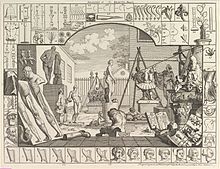
Hogarth wrote and published his ideas of artistic design in his book
Painter and engraver of modern moral subjects
Hogarth lived in an age when artwork became increasingly commercialized, being viewed in shop windows, taverns, and public buildings, and sold in printshops. Old hierarchies broke down, and new forms began to flourish: the ballad opera, the bourgeois tragedy, and especially, a new form of fiction called the novel with which authors such as Henry Fielding had great success. Therefore, by that time, Hogarth hit on a new idea: "painting and engraving modern moral subjects ... to treat my subjects as a dramatic writer; my picture was my stage", as he himself remarked in his manuscript notes.
He drew from the highly moralizing
Parodic borrowings from Old Masters
When analysing the work of the artist as a whole,
Personal life

On 23 March 1729, Hogarth eloped with

Sir James saw the match as unequal, as Hogarth was a rather obscure artist at the time. However, when Hogarth started on his series of moral prints, A Harlot's Progress, some of the initial paintings were placed either in Sir James' drawing room or dining room, through the conspiring of Jane and her mother, in the hopes of reconciling him with the couple. When he saw them, he inquired as to the artist's name and, upon hearing it, replied: "Very well; the man who can produce such representations as these, can also maintain a wife without a
Hogarth was initiated as a

His main home was in Leicester Square (then known as Leicester Fields), but he bought a country retreat in Chiswick in 1749, the house now known as Hogarth's House and preserved as a museum, and spent time there for the rest of his life.[87][88] The Hogarths had no children, although they fostered foundling children. He was a founding Governor of the Foundling Hospital.
Among his friends and acquaintances were many English artists and satirists of the period, such as Francis Hayman, Henry Fielding, and Laurence Sterne.
Death

On 25 October 1764, Hogarth was conveyed from his villa in Chiswick to his home in Leicester Fields, in weak condition. He had been in a weakened state for a while by this time, but was said to be in a cheerful mood and was even still working—with some help; doing more retouches on The Bench on this same day.[89] On 26 October, he received a letter from Benjamin Franklin and wrote up a rough draft in reply.[90]
Before going to bed that evening, he had boasted about eating a pound of beefsteaks for dinner, and reportedly looked more robust than he had in a while at this time.[91] However, when he went to bed, he suddenly began vomiting; something that caused him to ring his bell so forcefully that it broke. Hogarth died around two hours later,[92][93] in the arms of his servant, Mrs Mary Lewis.[90][94] John Nichols claimed that he died of an aneurysm, which he said took place in the "chest."[92][93][91] Horace Walpole claimed that he died of "a dropsy of his breast."[12]
Mrs Lewis, who stayed on with Jane Hogarth in Leicester Fields,[91] was the only non-familial person acknowledged financially in Hogarth's will and was left £100 (approximately £18,651.61 in 2020[95]) for her "faithful services."[90][96]

Hogarth was buried at
Farewell great Painter of Mankind
Who reach'd the noblest point of Art
Whose pictur'd Morals charm the Mind
And through the Eye correct the Heart.
If Genius fire thee, Reader, stay,
If Nature touch thee, drop a Tear:
If neither move thee, turn away,
For Hogarth's honour'd dust lies here.
Influence and reputation
Hogarth's works were a direct influence on John Collier, who was known as the "Lancashire Hogarth".[100] The spread of Hogarth's prints throughout Europe, together with the depiction of popular scenes from his prints in faked Hogarth prints, influenced Continental book illustration through the 18th and early 19th centuries, especially in Germany and France. He also influenced many caricaturists of the 18th, 19th and 20th centuries. Hogarth's influence lives on today as artists continue to draw inspiration from his work.
Hogarth's paintings and prints have provided the subject matter for several other works. For example,
Russell Banks' short story "Indisposed" is a fictional account of Hogarth's infidelity as told from the viewpoint of his wife, Jane. Hogarth was the lead character in Nick Dear's play The Art of Success,[101] whilst he is played by Toby Jones in the 2006 television film A Harlot's Progress.
Hogarth's House in Chiswick, west London, is now a museum;[102] the major road junction next to it is named the Hogarth Roundabout. In 2014 both Hogarth's House and the Foundling Museum held special exhibitions to mark the 250th anniversary of his death.[103][104] In 2019, Sir John Soane's Museum, which owns both The Rake's Progress and The Humours of an Election, held an exhibition which assembled all Hogarth's series of paintings, and his series of engravings, in one place for the first time.[105]
Stanley Kubrick based the cinematography of his 1975 period drama film, Barry Lyndon, on several Hogarth paintings.
In Roger Michell's 2003 film The Mother, starring Anne Reid and Daniel Craig, the protagonists visit Hogarth's tomb during their first outing together. They read aloud the poem inscribed there and their shared admiration of Hogarth helps to affirm their connection with one another.
Selected works
- Paintings
- William Hogarth's paintings
-
Before, 1731
-
After, 1731
-
Portrait of Inigo Jones, English Architect
-
The Wedding of Stephen Beckingham and Mary Cox, 1729
-
The Beggar's Opera VI, 1731, Tate Britain's version (22.5 x 30 ins.)
-
Southwark Fair, 1733
-
William Jones, the Mathematician, 1740
-
Hogarth's Portrait of Captain Thomas Coram, 1740
-
Miss Mary Edwards 1742
-
The Shrimp Girl 1740–1745
-
Roast Beef of Old England), 1749
-
1745 Jacobite rebellion
-
museof comedy and pastoral poetry, 1757–1758
-
The Bench, 1758
-
Hogarth's Servants, mid-1750s.
-
An Election Entertainment featuring the anti-Gregorian calendar banner "Give us our Eleven Days", 1755.
-
William Hogarth's Election series, Humours of an Election, plate 2
-
The Sleeping Congregation, 1728, Minneapolis Institute of Art
- Engravings
-
An early print of 1724, A Just View of the British Stage
-
Industry and Idleness, plate 11, The Idle 'Prentice executed at Tyburn
-
William Hogarth's engraving of the Jacobite Lord Lovat prior to his execution
-
Hogarth's satirical engraving of the radical politician John Wilkes.
-
Engraving, Before the 1736 print, based on the earlier "oyl"
-
Engraving, After
See also
- English art
- List of works by William Hogarth
- Ronald Paulson, the world's leading expert on Hogarth
- Judy Egerton, Hogarth curator, cataloguer, and commentator
Notes
- ^ "William Hogarth – Miss Mary Edwards : The Frick Collection". collections.frick.org.
- ^ "The Rococo Influence in British Art – dummies". dummies. Retrieved 23 June 2017.
- ^ According to Elizabeth Einberg, "by the time he died in October 1764 he had left so indelible a mark on the history of British painting that the term 'Hogarthian' remains instantly comprehensible even today as a valid description of a wry, satirical perception of the human condition." Hogarth the Painter, London: Tate Gallery, 1997, p. 17.
- ^ Ronald Paulson, Hogarth, vol. 1: The 'Modern Moral Subject', 1697–1732 (New Brunswick 1991), pp. 26–37.
- ^ Frederick Antal, Hogarth and His Place in European Art (London 1962); Robin Simon, Hogarth, France and British Art: The rise of the arts in eighteenth-century Britain (London 2007).
- ^ Bernd W. Krysmanski, Hogarth's Hidden Parts: Satiric Allusion, Erotic Wit, Blasphemous Bawdiness and Dark Humour in Eighteenth-Century English Art (Hildesheim, Zurich and New York: Georg Olms 2010).
- ^ Lamb, Charles, The Works of Charles and Mary Lamb, E.V. Lucas Publishing, 1811, Vol. 1, p. 82, "On the genius and character of Hogarth".
- ^ Charles Lamb, "On the genius and character of Hogarth; with some remarks on a passage in the writings of the late Mr. Barry".
- ^ Ellis Gamble Biographical Details. The British Museum.
- ^ W. H. K. Wright. The Journal of the Ex Libris Society, Volume 3 (A & C. Black, Plymouth, 1894)
- ^ Ronald Paulson, Hogarth, vol. 1 (New Brunswick 1991), pp. 26–37.
- ^ required.)
- ^ required.)
- Oxford Dictionary of National Biography(Oxford University Press, 2004)
- ^ Ronald Paulson, Hogarth, vol. 1: The 'Modern Moral Subject' (New Brunswick: Rutgers University Press, 1991), pp. 155-157.
- ^ See Ronald Paulson, Hogarth's Graphic Works (3rd edition, London 1989), no. 43. For more details, see David Dabydeen, Hogarth, Walpole and Commercial Britain (London 1987).
- ^ Paulson, Hogarth, vol. 1, pp. 172–185, 206–215.
- ^ Elizabeth Einberg, William Hogarth: A Complete Catalogue of the Paintings (New Haven and London: Yale University Press 2016), nos. 11, 20, 14, 13A–D.
- ^ Einberg, William Hogarth: A Complete Catalogue of the Paintings, no. 68.
- ^ Sarah Malcolm, The Hogarth Room, The Tate, retrieved 7 August 2014
- ^ Ronald Paulson, Hogarth, vol. 2 (New Brunswick 1992), pp. 1–4.
- ^ Einberg, William Hogarth: A Complete Catalogue of the Paintings, no. 63.
- ^ Paulson, Hogarth's Graphic Works, 3rd edition, no. 128.
- ^ Benjamin N. Ungar, "Take Me to the Southwark Fair: William Hogarth's Snapshot of the Life and Times of England's Migrating Early 18th Century Poor".
- .
- ^ Sean Shesgreen, Hogarth and the Times-of-the-Day Tradition (Ithaca, New York: Cornell UP, 1983).
- ^ Christina H. Kiaer, "Professional Femininity in Hogarth's Strolling Actresses Dressing in a Barn," Art History, 16, No. 2 (June 1993), pp. 239-65.
- ^ See Paulson, Hogarth's Graphic Works, 3rd edition, p. 35.
- ^ J. B. Nichols, 1833 p.192 "PLATE VIII. ... Britannia 1763"
- ^ J. B. Nichols, 1833 p.193 "Retouched by the Author, 1763"
- ^ Einberg, William Hogarth: A Complete Catalogue of the Paintings, nos. 21–26.
- ^ Ronald Paulson, Hogarth's Graphic Works, 3rd edition (London: The Print Room 1989), nos. 121–126.
- ISBN 1429919566.
- ^ For the paintings, see Einberg, William Hogarth: A Complete Catalogue of the Paintings, nos. 74–81. For the engravings, see Paulson, Hogarth's Graphic Works, 3rd edition, nos. 132–139.
- ^ Hogarth's The Rake's Progress and other of his works.
- ^ "A Rake's Progress". Sir John Soane's Museum. 2012. Retrieved 13 December 2013.
- ISBN 978-9053569139. Retrieved 13 December 2014.
- ^ Robert L. S. Cowley, Marriage A-la-Mode: a re-view of Hogarth's narrative art (Manchester University Press, 1983); Judy Egerton, Hogarth's 'Marriage A-la-Mode', London: The National Gallery 1997.
- ^ Paulson, Hogarth's Graphic Works, 3rd edition, nos. 158-163.
- ^ Print series in detail
- ^ Thackeray, William Makepeace, The English Humourists of the Eighteenth Century.
- ^ a b Paulson, Hogarth's Graphic Works, 3rd edition, nos. 168–179.
- ^ Paulson, Hogarth's Graphic Works, 3rd edition, nos. 185–186.
- ^ See Mark Hallett, The Spectacle of Difference (New Haven: Yale University Press, 1999), pp.198–222.
- ISBN 9781932112252.
- ISBN 9781780226491.
- ^ See "Hogarth, the father of the modern cartoon", The Telegraph, 13 May 2015.
- ^ See "William Hogarth, Beer Street and Gin Lane, two prints", British Museum. Archived 31 October 2015 at the Wayback Machine
- ^ Einberg, William Hogarth: A Complete Catalogue of the Paintings, no. 185.
- ^ Robin Simon, Shakespeare, Hogarth and Garrick: Plays, Painting and Performance (London 2023).
- ^ Paulson, Hogarth's Graphic Works, 3rd edition, no. 166.
- ISBN 0300058330
- ^ Einberg, William Hogarth: A Complete Catalogue of the Paintings, no. 128.
- ^ Einberg, William Hogarth: A Complete Catalogue of the Paintings, no. 148.
- ^ Paulson, Hogarth's Graphic Works, 3rd edition, no. 214.
- ^ Hogarth & John Wilkes - UK Parliament Living Heritage
- ISBN 9780520213005.
- ISBN 9780520213005.
- ISBN 9780520213005.
- ^ Elizabeth Einberg, William Hogarth: A Complete Catalogue of the Paintings (New Haven and London: Yale University Press 2016), nos. 90–91.
- ^ Einberg, William Hogarth: A Complete Catalogue of the Paintings, no. 198.
- ^ Einberg, William Hogarth: A Complete Catalogue of the Paintings, no. 204.
- ^ M. J. Liversidge, William Hogarth's Bristol Altar-Piece (Bristol Historical Association pamphlet, no. 46, 1980) 24 pp.
- ^ Einberg, William Hogarth: A Complete Catalogue of the Paintings, no. 201.
- ^ J. B. Nichols, 1833 p.63 "in one corner introduced my own portrait"
- ^ Paulson, Hogarth's Graphic Works, 3rd edition, nos. 152, 158–163, 167.
- ^ Einberg, William Hogarth: A Complete Catalogue of the Paintings, no. 194.
- ^ Einberg, William Hogarth: A Complete Catalogue of the Paintings, no. 207.
- ^ Paulson, Hogarth's Graphic Works, 3rd edition, no. 232.
- ^ Einberg, William Hogarth: A Complete Catalogue of the Paintings, nos. 214–217.
- .
- ^ Paulson, Hogarth's Graphic Works, 3rd edition, no. 211.
- ^ Paulson, Hogarth's Graphic Works, 3rd edition, nos. 206, 210a, 211, 216.
- ^ Ronald Paulson, Hogarth, vol. 3 (New Brunswick 1993), pp. 213–216.
- ISBN 978-0-300-07346-1
- ^ Tate. "Rococo – Art Term | Tate". Tate. Retrieved 23 June 2017.
- ^ Timbs, John (1881). Anecdote Lives of William Hogarth, Sir Joshua Reynolds, Thomas Gainsborough, Henry Fuseli, Sir Thomas Lawrence, and J.M.W. Turner. R. Bentley. pp. 57–58.
- ^ Geoff Quilley, "The Analysis of Deceit: Sandby's Satires against Hogarth", in John Bonehill and Stephen Daniels (eds.), Paul Sandby: Picturing Britain, exh. cat., London: Royal Academy of Arts, 2009, 38-47.
- ^ Michael Kitson, "Hogarth's 'Apology for Painters'", Walpole Society, 41 (1966-1968), pp. 46-111.
- ^ William Hogarth, The Analysis of Beauty, With the Rejected Passages from the Manuscript Drafts and Autobiographical Notes, edited by Joseph Burke (Oxford, 1955), pp. 201-31.
- ^ Sala, George Augustus (1866). William Hogarth: Painter, Engraver and Philosopher. London, England: Smith, Elder & Company. p. 141.
- ^ Timbs, John (1887). Anecdote Lives of William Hogarth, Sir Joshua Reynolds, Thomas Gainsborough, Henry Fuseli, Sir Thomas Lawrence, and J.M.W. Turner. London, England: Richard Bentley & Sons. p. 14.
- ^ Cook, Thomas (1808). Hogarth Restored. The Whole Works of the Celebrated William Hogarth, as Originally Published: with a Supplement, Consisting of Such of His Prints as Were Not Published in a Collected Form. London, England: John Stockdale and G. Robinson. p. 223.
- ^ Clerk, Thomas (1812). The Works of William Hogarth, Elucidated by Descriptions, Critical, Moral and Historical; To Which is Prefixed Some Account of His Life. Vol. 1. London, England: James Ballantyne & Co. p. 8.
- ISBN 9780827425231.
- ^ See references in this biography.
- ^ "Hogarth's House | Hounslow.info". 23 January 2018. Archived from the original on 23 January 2018. Retrieved 3 August 2018.
- ^ Joel Taylor (11 March 2005). "Camden New Journal". camdennewjournal.co.uk. Retrieved 21 May 2013.
- ^ Nichols, John; Steevens, George; Ireland, Samuel (1900). The Works of William Hogarth, Including the Analysis of Beauty and Five Days' Peregination. Vol. 4. Philadelphia, Pennsylvania: George Barrie & Son. p. 97.
- ^ a b c Nichols, John; Steevens, George; Ireland, Samuel (1900). The Works of William Hogarth, Including the Analysis of Beauty and Five Days' Peregination. Vol. 4. Philadelphia, Pennsylvania: George Barrie & Son. p. 98.
- ^ a b c Nichols, John; Steevens, George; Ireland, Samuel (1900). The Works of William Hogarth, Including the Analysis of Beauty and Five Days' Peregination. Vol. 4. Philadelphia, Pennsylvania: George Barrie & Son. p. 99.
- ^ ISBN 9785875310782.
- ^ a b Brown, Gerard Baldwin (1905). William Hogarth. London, England: Walter Scott Publishing Co. Ltd. p. 107.
- ^ Berry, Erick (1964). The Four Londons of William Hogarth. David McKay Publications. p. 219.
- ^ "Inflation calculator". Office for National Statistics. Bank of England. Retrieved 25 March 2023.
- ^ Ireland, John (1791). William Hogarth. Vol. 1. London, England: J. & J. Boydell. pp. 107, 108, 109.
- ^ "The Churchyard". St Nicholas Church, Chiswick. Retrieved 8 November 2019.
- ^ Location of Hogarth's grave on Google Maps
- ^ McDonagh, Melanie (10 October 2019). "Hogarth: Place and Progress review – Sordid, subversive and richly comic". Evening Standard.
- ISBN 0-946571-19-8.
- ^ Mariacristina Cavecchi, "Hogarth's Progress in Nick Dear's The Art of Success," in Caroline Patey, Cynthia E. Roman, Georges Letissier (eds.), Enduring Presence: William Hogarth's British and European Afterlives, vol. 1 (Peter Lang, 2021), 183-204.
- ^ Val Bott, Hogarth's House (London, 2012).
- ^ "Hogarth's House". Museums London. Retrieved 8 November 2019.
- ^ "Progress 06 Jun 2014 – 07 Sep 2014 | Exhibitions & Displays". Foundling Museum. Retrieved 8 November 2019.
- ^ Jones, Jonathan (9 October 2019). "Hogarth: Place and Progress review – a heartbreaking epic of London squalor". The Guardian.
References
- William Hogarth, John Bowyer Nichols, ed. Anecdotes of William Hogarth, Written by Himself (J. B. Nichols and Son, 25 Parliament Street, London, 1833)
- ISBN 978-0836981452)
- Quennell, Peter. "Hogarth's Election Series." History Today (Apr 1953) 3#4 pp 221–232
- Frederick Antal, Hogarth and His Place in European Art (London 1962).
- ISBN 3-86150-042-6)
- Sean Shesgreen, Hogarth 101 Prints (New York: Dover 1973).
- David Bindman, Hogarth (London 1981).
- Sean Shesgreen, Hogarth and the Times-of-the-Day Tradition (Ithaca, New York: Cornell UP, 1983).
- Ronald Paulson, Hogarth's Graphic Works (3rd edn, London 1989).
- Ronald Paulson, Hogarth, 3 vols. (New Brunswick 1991–93).
- Elizabeth Einberg, Hogarth the Painter (London: Tate Gallery, 1997).
- Jenny Uglow, Hogarth: A Life and a World (London 1997).
- Frédéric Ogée and Hans-Peter Wagner, eds., William Hogarth: Theater and the Theater of Life (Los Angeles, 1997).
- Hans-Peter Wagner, William Hogarth: Das graphische Werk (Saarbrücken, 1998; revised edition, Trier 2013).
- David Bindman, Frédéric Ogée and Peter Wagner, eds. Hogarth: Representing Nature's Machines (Manchester, 2001)
- Bernadette Fort, and Angela Rosenthal, eds., The Other Hogarth: Aesthetics of Difference (Princeton: Princeton UP, 2001)
- Christine Riding and Mark Hallet, "Hogarth" (Tate Publishing, London, 2006).
- Robin Simon, Hogarth, France and British Art: The rise of the arts in eighteenth-century Britain (Paul Holberton Publishing, 2007)
- Ilias Chrissochoidis, "Handel, Hogarth, Goupy: Artistic intersections in Handelian biography", Early Music 37/4 (November 2009), 577–596.
- Bernd W. Krysmanski, Hogarth's Hidden Parts: Satiric Allusion, Erotic Wit, Blasphemous Bawdiness and Dark Humour in Eighteenth-Century English Art (Hildesheim, Zurich, New York: Olms-Verlag, 2010 ISBN 978-3487144719)
- Johann Joachim Eschenburg, Über William Hogarth und seine Erklärer, ed. Till Kinzel (Hanover: Wehrhahn, 2013 ISBN 978-3-8652-5347-7)
- Cynthia Ellen Roman, ed., Hogarth's Legacy (New Haven and London: Yale University Press, 2016)
- Elizabeth Einberg, William Hogarth: A Complete Catalogue of the Paintings (New Haven and London, Yale University Press for Paul Mellon Centre for Studies in British Art, 2016)
- Robin Simon, Shakespeare, Hogarth and Garrick: Plays, Painting and Performance (Paul Holberton Publishing, 2023)
External links
- 141 artworks by or after William Hogarth at the Art UK site
- Hind, C. Lewis (1910). Hogarth. Masterpieces in Colour. London: T.C. & E.C. Jack.
- The Works of William Hogarth, 1822 Heath edition (engravings, with commentaries by John Nichols)
- William Hogarth's biography, style, artworks and influences
- William Hogarth at The National Gallery
- William Hogarth: Critical Essays
- William Hogarth and 18th-Century Print Culture
- The Site for Research on William Hogarth (annotated online bibliography)
- Hogarth exhibition at Tate Britain, London (7 February – 29 April 2007)
- William Hogarth at Wikigallery
- Works by William Hogarth at Project Gutenberg
- Works by or about William Hogarth at Internet Archive
- The Analysis of Beauty, 1753 (abridged 1909 edition)
- 'Hogarth's London', lecture by Robin Simon at Gresham College, 8 October 2007 (available for download as MP3, MP4 or text files)
- Hogarth's London video hosted at Tate Britain's website by Martin Rowson
- William Hogarth's Works hosted at The Victorian Web
- William Hogarth on Lambiek's Comiclopedia

